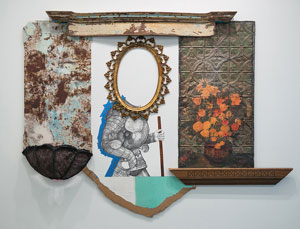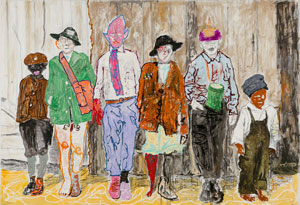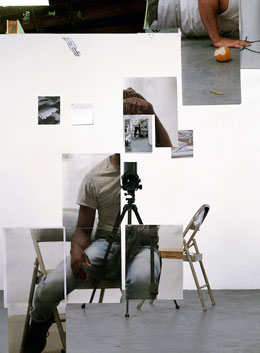Portraits of Silence
John Haberin New York City
David Shrobe, Farley Aguilar, and Paul Mpagi Sepuya
As portrait painters go, David Shrobe has trouble capturing his sitters. Then again, they may have departed long ago. Then, too, others may have silenced them forcibly and taken them away.
African American artists have a tough job—to give voice to the silenced. So does Farley Aguilar, a Latin American artist working in the United States. They do it anyway. Found images and quotes from older art add to their flair and deepen their sense of history. Paul Mpagi Sepuya does much the same in photo collage, as confessions of racial and sexual identity. As confessions go, though, they are not easy to decipher. 
Black life with chair caning
Politics and portraiture have always gone together, just as with Renaissance princes—and with the same risk of sycophancy. Such talented painters as Titus Kaphar with Reginald Dwayne Betts, Barkley L. Hendricks with art history as African American portraits, Kehinde Wiley with his public sculpture, Amy Sherald with her Obama state portrait, Marcus Leslie Singleton with a greater modesty, or Mickalene Thomas risk leaving their subjects as shallow and glittery as their backdrops. David Shrobe, though, has more in mind than a poster child for the black community. One face appears only as its outlines, the rest cut out of its heavy frame. Even then, the blackness of a silhouette succumbs to the light checkerboard of gridded paper. Another man loses his head and lower body alike to picture frames, leaving only a well-dressed torso floating in the space between them, as Ethereal Plane.
From what survives of their flesh, they were African American portraits. Yet there, too, others have done their best to efface their identity. That torso holds out a sheet of writing paper, as if to deliver a message, but itself half cut off and entirely blank. A found shop sign pledges We Accept. Does it declare racial tolerance or just an acceptance of food stamps? Another sign, promising a "great buy," makes the act of effacement explicit with the starting letters of fuhgettaboutit.
Regardless, they belong to history. That includes the history of the black community—and the history of their materials to back it up. As portrait painters go, Shrobe is also sparing of paint. He prefers pencil, reproductions, and assemblage. Even when he throws in a palette, it appears in pristine condition, with not a touch of oil color. It might be a cutting board instead anyway.
He invites one to imagine him scouring the streets, cherishing its signage and discarded picture frames, the more elaborate the better. He also invites one to look to other histories, meaning both black history and the history of art. The man with a message dresses for the eighteenth century, with the very definition of a free America already in doubt. Another body wears armor from a still earlier time, as Knight Shine. Is the warrior black or a European conqueror? Is he becoming free or taking others into servitude?
Shrobe has an obvious debt to Modernism as well as to older art. His methods go back at the very least to Robert Rauschenberg and to Rauschenberg's combine paintings and Rauschenberg collaborations. One work contains chair caning, like a Picasso still life. Like many another black artist, he is also out to recover a people and their history. He dares one to feel their loss as well. And, as for so many working after Romare Bearden, that project begins on the streets of Harlem.
Like Kerry James Marshall, Shrobe is equally at home on the street and in the museum—and determined to bring them together. Like Marshall, too, he embraces what he sees as invisible men. He lacks Marshall's specifics of gathering places and individual lives, not to mention the exuberance and color, and then he casts doubt on just that. He asks to make up for it with acts of recovery. When his groceries include peaches, one might think of a breakfast table or the Deep South. When the picture frames lie empty but for wallpaper and weathered wood, one might hope to fill them once and for all.
Carnival in Nicaragua
Farley Aguilar works from found photographs, much like Luigi Ghirri. His gallery even speaks of them as antiquated, but not as antiquities of Latin American art that Mestre Didi happily threw away. By the time he is through, though, Latin American art may feel ripped right out of the headlines, a graphic novel, or a textbook history of modern art. But which? The sheer elusiveness of his images contributes to their punch. So, too, do their ravaged surfaces and eclecticism.
 How could I not pin down the seated mother sewing a flag, child by her side? It looks so comforting, like her old-fashioned sofa and print dress. It could be an emblem of family and patriotism, but from what war? The theme appears in posters back in World War I, and Americans have been fighting over the flag ever since. They fought over the war in Vietnam, back when the police were "pigs," and the word pig appears above the painting on the gallery's Web site, with double exclamation points—scrawled on the wall in a jagged oval like the ones used in comic strips for pow, zap, and bam. In the climate of wars now, left over from George W. Bush, defenders wield images like this as a sucker punch.
How could I not pin down the seated mother sewing a flag, child by her side? It looks so comforting, like her old-fashioned sofa and print dress. It could be an emblem of family and patriotism, but from what war? The theme appears in posters back in World War I, and Americans have been fighting over the flag ever since. They fought over the war in Vietnam, back when the police were "pigs," and the word pig appears above the painting on the gallery's Web site, with double exclamation points—scrawled on the wall in a jagged oval like the ones used in comic strips for pow, zap, and bam. In the climate of wars now, left over from George W. Bush, defenders wield images like this as a sucker punch.
Aguilar's favorite subject packs another kind of punch—kids or adults, mostly male, lined up against a wall. They could be showing off or hanging out. Aguilar could be speaking to racism and reconciliation in that mother's interior as well. A painting above the sofa shrouds a couple's heads in black hoods, like the Ku Klux Klan for Wardell Milan in reverse. A painting beside it marks another couple with X's and O's. They bring love and kisses, but also tokens of a game with no winners.
The lineups could come from anywhere, from a carnival to a criminal investigation. So, too, could Aguilar's technique. He slathers on graphite, oil, and oil stick before scratching into them. Lines and layers compete for attention, as marks of painterly comforts and raw violence. They serve his actors for showing off or as masks. They also add fragments of text—although, like everything else here, difficult to read.
As for Curtis Talwst Santiago, the carnival has deep roots in art history. It comes close to quoting James Ensor, although the agonies and the comedy have ancestors in Edvard Munch, Munch prints, German Expressionism and Nazi-looted art, and Otto Dix as well. It verges, too, on Georg Baselitz, Baselitz drawings, and Neo-Expressionism, but less portentous and right-side up. The show's title, "Bad Color Book," may evoke a coloring book as well. Then again, it could refer merely to the bright colors and postmodern boasts of "bad art." Either way, it is broken English, another token of border crossings.
How did an artist from Nicaragua end up in northern European art? Maybe through events at home, and the tastes of street culture and violence could refer to civil war there. Maybe, too, through the United States, and he has settled in Florida. My first impulse is still to see American themes and American cities. Aguilar moves across cultures without hiding his estrangement. He knows that too many of the divisions lie within.
Mirrors and curtains
Paul Mpagi Sepuya must love being in the studio. He must love even more hiding its traces. His photographs bring its contents ever so close to the picture plane, but isolated from one another and their purpose. His hands reach out to them or hold them, patiently. Collage may bring them closer together or more firmly apart. They record a work in progress that may never appear apart from its making. 
He has been making and remaking it for a while now, as a study in gender and blackness. He appeared at the Studio Museum in 2010, in a show of "conceptual art and identity politics." Soon after, his studio itself entered the museum, as he became an artist in residence, and he wrapped up the year by taking it into the museum's galleries. Sepuya transferred it bit by bit over the course of an exhibition. Additional photographs recorded its dismantling behind the scenes. The museum called the show "Evidence of Accumulation," but it could just as well have said evidence of dispersal or the accumulation of evidence.
His work still serves as elusive keys to his identity, as in MoMA's 2018 "New Photography." Those hands may reach out to his own, in a mirror. They may also reach out to another's, a white male's. Perhaps the same very men lie on their back in portraits. The casual air and cluttered compositions can weaken them. Yet they also have a frank vulnerability and eroticism, much like the work of Nan Goldin.
Studio materials include curtains, in black, white, or a velvety red. They may lie within a picture or over it, almost covering it completely. So may other images, by the very nature of collage. As if to distance them further, they sometimes appear in black and white. Rephotographing then brings them closer to a finished work or still further away. All one can say for sure Sepuya that he approaches them with care and, often as not, with love.
It may help to examine the photos less for meaning than for oppositions. A structuralist would say that meaning always emerges from oppositions anyway. Here the pairs include mirrors and curtains, the outside world and the studio, layering and covering, the work and the work in progress, the artist and subject, patience and desire, black and white, Harlem and Chelsea, LA and New York. (Sepuya is from Southern California and divides his time between east and west coast.) Maybe, too, one should look past the contraries. At the opening, the gallery served neither red nor white, but rosé, and I did not stay to try it.
Black and white appear, too, in portraits by Pieter Hugo. Hugo photographs children and emerging adults in Rwanda and his native South Africa. They may look lost in flowery white dresses or comforted by a bed of red earth. One boy holds another in his arms, like father and son or a Madonna and child, but without a smile or a myth. They all play out against a loss of innocence, thanks to their births after 1994—the year of genocide in one country and the end of apartheid in the other. Like Sepuya, they lie between narratives, while questioning them all.

David Shrobe ran at Thierry Goldberg and Farley Aguilar at Lyles & King both through February 12, 2017. Paul Mpagi Sepuya ran at Yancey Richardson through March 18 and in a group show at Sikkema Jenkins with Deana Lawson and Judy Linn through February 18, Pieter Hugo at Yossi Milo through March 11.




